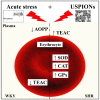Preliminary Findings on the Effect of Ultrasmall Superparamagnetic Iron Oxide Nanoparticles and Acute Stress on Selected Markers of Oxidative Stress in Normotensive and Hypertensive Rats
- PMID: 35453436
- PMCID: PMC9030389
- DOI: 10.3390/antiox11040751
Preliminary Findings on the Effect of Ultrasmall Superparamagnetic Iron Oxide Nanoparticles and Acute Stress on Selected Markers of Oxidative Stress in Normotensive and Hypertensive Rats
Abstract
Several studies have reported that the administration of various nanoparticles in vivo can cause oxidative stress. The combination of ultrasmall superparamagnetic iron oxide nanoparticles (USPIONs) and acute stress was selected because, during intravenous application of a contrast agent, patients are exposed to psycho-emotional stress. This study was designed to investigate the effect of acute stress and USPIONs on selected markers of oxidative stress (antioxidant capacity, superoxide dismutase, glutathione peroxidase and catalase activities, levels of advanced oxidation protein products, protein carbonyls, lipoperoxides and 8-isoprostanes) in plasma and erythrocytes in normotensive Wistar-Kyoto rats (WKY) and spontaneously hypertensive rats (SHR). In the WKY and SHR groups, there was a significant main effect of genotype between groups on studied markers except protein carbonyls and lipoperoxides. In SHR, the combination of acute stress and USPIONs increased the antioxidant capacity of plasma and the selected enzyme activities of erythrocytes. In WKY, the combination of acute stress and USPIONs decreased the antioxidant capacity of erythrocytes and reduced levels of advanced oxidation protein products in plasma. Our study points to the fact that, when hypertensive subjects are treated with iron oxide nanoparticles, caution should be taken, especially in stress conditions, since they seem to be more vulnerable to oxidative stress produced by USPIONs.
Keywords: USPIONs; acute stress; erythrocytes; hypertension; markers of oxidative damage; oxidative stress; plasma; ultrasmall superparamagnetic iron oxide nanoparticles.
Conflict of interest statement
The authors declare no conflict of interest.
Figures





References
-
- Park Y.C., Smith J.B., Pham T., Whitaker R.D., Sucato C.A., Hamilton J.A., Bartolak-Suki E., Wong J.Y. Effect of PEG Molecular Weight on Stability, T₂ Contrast, Cytotoxicity, and Cellular Uptake of Superparamagnetic Iron Oxide Nanoparticles (SPIONs) Colloids Surf. B Biointerfaces. 2014;119:106–114. doi: 10.1016/j.colsurfb.2014.04.027. - DOI - PMC - PubMed
Grants and funding
LinkOut - more resources
Full Text Sources

